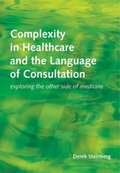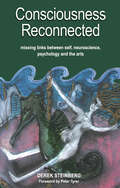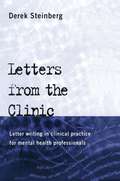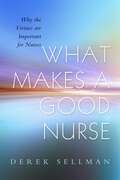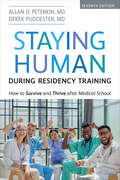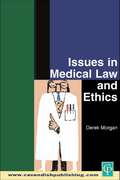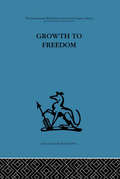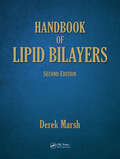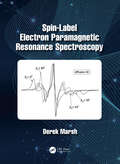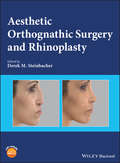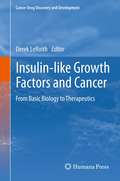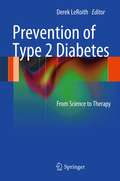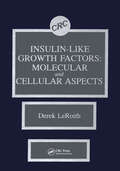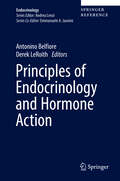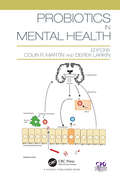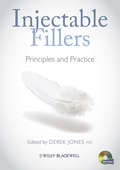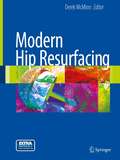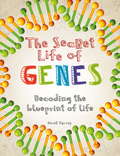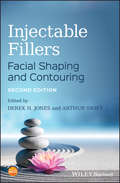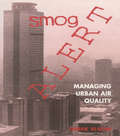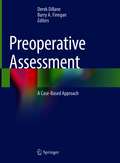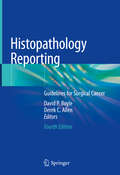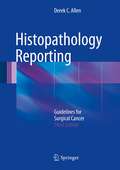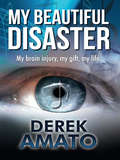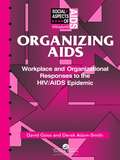- Table View
- List View
Complexity in Healthcare and the Language of Consultation: Exploring the Other Side of Medicine
by Derek SteinbergThis book provides an important contribution to the new and growing field of 'narrative-based medicine'. It specifically addresses the largest area of medical activity primary care. It provides both a theoretical framework and practical skills for dealing with individual consultations family work clinical supervision and teamwork and offers a comprehensive approach to the whole range of work in primary care. Using a wide range of clinical examples it shows how professionals in primary care can help clarify patients' existing stories and elucidate new stories. It can be used as a training resource and includes exercises and summaries of key points to consider. It is based on and describes an established evaluated training method and is of immediate and significant practical use to readers. It is essential reading for general practitioners practice nurses and others in the primary care team psychologists family therapists counsellors and other professionals attached to primary care. GP trainers tutors and course organisers will find it a valuable educational tool. Professionals elsewhere in primary care such as pharmacists dentists and optometrists and academics in medical sociology and medical anthropology will also find it very useful.
Consciousness Reconnected: Missing Links Between Self, Neuroscience, Psychology and the Arts
by Derek SteinbergWhat is consciousness? The answer to this question has eluded thinkers for millennia. In modern times, scientists have struggled to find a complete answer, often hampered by the limitations of their particular specialisms. Derek Steinberg’s unique approach constructs a multi-faceted model of mind involving science and the arts, from which the sense of personal identity emerges. In a masterful tour-de-force, he establishes links between otherwise distinct or even conflicting disciplines. In this radical departure, the author argues that the arts, literature and human culture in the broadest sense make their contributions to understanding consciousness and the sense of self, though they are rarely acknowledged in mainstream debate. Rather than focusing only on what lies between the ears, Steinberg casts a wide net. He explores the connections between sciences and the humanities as he takes the debate into new areas. This book is fascinating and enlightening reading for everyone interested in human nature and the psyche, as well as for students and professionals in the fields of neuroscience, psychiatry, psychology, medicine, social science, anthropology, philosophy and the arts, for whom the book is a breakthrough in the challenge of cross-disciplinary collaboration.
Letters From the Clinic: Letter Writing in Clinical Practice for Mental Health Professionals
by Derek SteinbergIn every field of therapeutic practice a significant amount of time is spent writing letters about and to patients. In Letters From the Clinic Derek Steinberg applies detailed literary and psychological analysis to over 40 letters, highlighting why certain words or phrases were used, how they could have been put better, and builds around them principles and theoretical positions based on narrative therapy, consultative approaches and the psychological impact of words and phrases.Using the context of child, adolescent and family psychiatry, while also applicable to all therapeutic work, the book deals with issues such as* explaining clinical conditions and treatments* confirming clinical contracts* conveying difficult advice and painful news* missed appointments and other practicalitiesEach letter is followed by detailed annotations and discussion.Letters From the Clinic will prove a valuable tool to all those working in clinical and therapeutic practice.
What Makes a Good Nurse
by Derek SellmanIn recent years, the human values at the heart of the nursing profession seem to have become side-lined by an increased focus on managerialist approaches to health care provision. Nursing's values are in danger of becoming marginalised further precisely because that which nursing does best - providing care and helping individuals through the human trauma of illness - is difficult to measure, and therefore plays little, if any, part in official accounts of outcome measures. Derek Sellman sets out the case for re-establishing the primacy of the virtues that underpin the practice of nursing in order to address the question: what makes a good nurse? He provides those in the caring professions with both a rationale and a practical understanding of the importance that particular character traits, including justice, courage, honesty, trustworthiness and open-mindedness, play in the practice of nursing, and explains why and how nurses should strive to cultivate these virtues, as well as the implications of this for practice. This original and thought-provoking book will be essential reading for nurses and nursing students, care workers, care commissioners, and many others who work in the caring professions.
Staying Human during Residency Training: How to Survive and Thrive after Medical School, Seventh Edition
by Allan D. Peterkin, MD Derek Puddester, MDThe ultimate survival guide for medical students, interns, residents, and fellows, Staying Human during Residency Training provides time-tested advice and the latest information on every aspect of a resident’s life – from choosing a residency program to coping with stress, enhancing self-care, and protecting personal and professional relationships. The book features hundreds of tips on how to cope with sleep deprivation, time pressures, and ethical and legal issues. Updated to reflect the latest research and resources, the seventh edition provides new emphasis on virtual practice, gender, diversity, and accountability in the context of medical education.. It offers practical strategies learned from new technologies and new insight on the COVID-19 pandemic regarding public health, virtual appointment protocols, and AI developments. Presenting practical antidotes regarding cynicism, careerism, and burnout, the book also offers guidance on fostering more empathic connections with patients and deepening relationships with colleagues, friends, and family. Acknowledged by thousands of doctors across North America as an invaluable resource, Staying Human during Residency Training has helped to shape notions of trainee well-being for medical educators worldwide. Offering wise, compassionate, and professional counsel, this new edition again shows why it is required reading for medical students and new physicians pursuing postgraduate training.
Issues in Medical Law and Ethics
by Derek MorganThirty years ago, English jurist Patrick Devlin wrote: "Is it not a pleasant tribute to the medical profession that by and large it has been able to manage its relations with its patients ... without the aid of lawyers and law makers". Medical interventions at the beginnings and the endings of life have rendered that assessment dated if not defeated. This book picks up some of the most important of those developments and reflects on the legal and social consequences of this metamorphosis over the past ten years, and will be of interest to students of law, sociology and ethics who want a considered and critical introduction to, and reflection on, key issues in these pivotal moments of human life.
Growth to Freedom: The Psychosocial Treatment of Delinquent Youth
by Derek MillerTavistock Press was established as a co-operative venture between the Tavistock Institute and Routledge & Kegan Paul (RKP) in the 1950s to produce a series of major contributions across the social sciences. This volume is part of a 2001 reissue of a selection of those important works which have since gone out of print, or are difficult to locate. Published by Routledge, 112 volumes in total are being brought together under the name The International Behavioural and Social Sciences Library: Classics from the Tavistock Press. Reproduced here in facsimile, this volume was originally published in 1964 and is available individually. The collection is also available in a number of themed mini-sets of between 5 and 13 volumes, or as a complete collection.
Handbook of Lipid Bilayers
by Derek MarshNow in its second edition, the Handbook of Lipid Bilayers is a groundbreaking work that remains the field's definitive text and only comprehensive source for primary physicochemical data relating to phospholipid bilayers. Along with basic thermodynamic data, coverage includes both dynamic and structural properties of phospholipid bilayers. It is an
Spin-Label Electron Paramagnetic Resonance Spectroscopy
by Derek MarshSpin-label electron paramagnetic resonance (EPR) spectroscopy is a versatile molecular probe method that finds wide application in molecular biophysics and structural biology. This book provides the first comprehensive summary of basic principles, spectroscopic properties, and use for studying biological membranes, protein folding, supramolecular structure, lipid-protein interactions, and dynamics. The contents begin with discussion of fundamental theory and practice, including static spectral parameters and conventional continuous-wave (CW) spectroscopy. The development then progresses, via nonlinear CW-EPR for slower motions, to the more demanding time-resolved pulse EPR, and includes an in-depth treatment of spin relaxation and spectral line shapes. Once the spectroscopic fundamentals are established, the final chapters acquire a more applied character. Extensive appendices at the end of the book provide detailed summaries of key concepts in magnetic resonance and chemical physics for the student reader and experienced practitioner alike. Key Features: Indispensable reference source for the understanding and interpretation of spin-label spectroscopic data in its different aspects. Tables of fundamental spectral parameters are included throughout. Forms the basis for an EPR graduate course, extending up to a thorough coverage of advanced topics in Specialist Appendices. Includes all necessary theoretical background. The primary audience is research workers in the fields of molecular biophysics, structural biology, biophysical chemistry, physical biochemistry and molecular biomedicine. Also, physical chemists, polymer physicists, and liquid-crystal researchers will benefit from this book, although illustrative examples used are often taken from the biomolecular field. Readers will be postgraduate researchers and above, but include those from other disciplines who seek to understand the primary spin-label EPR literature.
Aesthetic Orthognathic Surgery and Rhinoplasty
by Derek M. SteinbacherComprehensive in scope, Aesthetic Orthognathic Surgery and Rhinoplasty presents orthognathic surgery from an aesthetic perspective, encompassing analysis, diagnosis, treatment, 3D virtual planning, and adjunctive procedures. Easily accessible clinical information presented in a concise and approachable format Well-illustrated throughout with more than 1,000 clinical photographs Includes access to a companion website with videos of surgical procedures
Insulin-like Growth Factors and Cancer
by Derek LeroithThe book will detail the history, successes, and failures of targeted therapies for cancer, with a particular focus on IGF systems and cancer.
Prevention of Type 2 Diabetes
by Derek LeroithThere is a world-wide epidemic on obesity. This epidemic is driving the immense proportions of Type 2 diabetes across the globe. While there are numerous therapies for treating Type 2 diabetes, the most effective therapy is prevention. Prevention of Type 2 diabetes can be achieved properly by simultaneous prevention of obesity. Prediabetes, or metabolic syndrome, is the period between simple obesity and diabetes, and this critical period needs to be identified in a more consistent and systematic manner by clinicians worldwide. Clinical trials have indicated that diabetes prevention can be achieved by lifestyle changes and also by certain medications, though none are yet approved for use in prevention. On the other hand, there are funding agencies such as the NIH, CDC, and State Institutions that are interested in studying the prevention paradigms in different communities and ethnic minorities who are most prone to this epidemic. For these reasons, this title by renowned physician-scientist Derek LeRoith is both timely and vitally important for academic physicians, practitioners, allied health care providers, analysts, community activists, and all others interested in this increasing epidemic. This book provides a unique and comprehensive synthesis of the prevention and early diagnosis of Type 2 Diabetes, focusing on identifying risk factors and then moving into topics that address how to prevent their progression to full-blown diabetes. The difficult task of changing patients' behavior is given special emphasis. The chapters in this practical volume are written by a wide range of international experts, refelecting the editor's distinguished, internationally renowned career. The volume is organized in eight sections: an introduction to the overall issue of prevention, definitions of values based on ADA guidelines, pathophysiology, discussion of a range of interventional trials regarding prevention, and an overview of state-of-the-art clinical management approaches. Comprehensive and timely, Prevention of Type 2 Diabetes: From Science to Therapy is an essential reference for those treating and researching Type 2 Diabetes.
Insulin-like Growth Factors: Molecular and Cellular Aspects
by Derek LeRoithDuring the past decade, the continued interest in insulin-related growth factors has been documented by a plethora of research programs and publications focused on these growth factors. Both molecular and cellular biological techniques have improved and enabled investigators to study the properties of the growth factors in depth.This volume covers the molecular (genetic) aspects of the growth factors, their binding proteins and receptors, as well as those factors affecting their gene transcription and translation. In addition, aspects of the cellular action of these growth factors through their receptors and how this impacts normal cellular function are discussed. The book will provide valuable information for researchers in physiology, biology, endocrinology, and metabolism.
Principles of Endocrinology and Hormone Action
by Antonino Belfiore Derek LeRoithThis volume provides comprehensive coverage of the current knowledge of the physiology of the endocrine system and hormone synthesis and release, transport, and action at the molecular and cellular levels. It presents essential as well as in-depth information of value to both medical students and specialists in Endocrinology, Gynecology, Pediatrics, and Internal Medicine. Although it is well established that the endocrine system regulates essential functions involved in growth, reproduction, and homeostasis, it is increasingly being recognized that this complex regulatory system comprises not only hormones secreted by the classic endocrine glands but also hormones and regulatory factors produced by many organs, and involves extensive crosstalk with the neural and immune system. At the same time, our knowledge of the molecular basis of hormone action has greatly improved. Understanding this complexity of endocrine physiology is crucial to prevent endocrine disorders, to improve the sensitivity of our diagnostic tools, and to provide the rationale for pharmacological, immunological, or genetic interventions. It is such understanding that this book is designed to foster.
Probiotics in Mental Health
by Colin R. Martin Derek LarkinThe concept that the gut and brain are intricately linked is widely accepted not just within the lay community but increasingly within scientific and therapeutic circles as well. Terms such as "heartache" and "gut wrenching" are more than mere metaphor, they represent key fundamental aspects of human experience which all individuals will invariably endure from time to time. The relationship between the gut and brain is complex but fundamental to health and wellbeing. Increasing and compelling evidence supports the existence of a relationship between the health and status of the gut and the manifestation of significant psychopathology. Uniquely within the field of mental health and psychiatry, the role of gut flora and probiotics in both the understanding and treatment of mental illness represents an emerging science whether the potential for therapeutic intervention, through the use of probiotics, offers an opportunity to determine efficacy within a coherent evidence-based model of both action and pathology or, moreover, offers interventions that are comparatively benign compared to the side-effect profile associated with most drugs used to treat mental illness. <P><P>Probiotics in Mental Health examines the role of probiotics in a range of clinical presentations associated with significant psychopathology and facilitates a reconsideration of how mental illness may be conceptualised within a coherent gut-brain model of health and wellbeing. Under the rubric of enhancing wellbeing rather than dwelling on illness and disease, this exciting new volume not only comprises the latest evidence in the field but also advocates an approach characterised by the understanding of mental disorder within an evidence-based model and the pursuit of mental health and wellbeing through the most benign of interventions.
Injectable Fillers
by Derek JonesDermal fillers are the fastest growing tools in the cosmetic physician's armamentarium for refreshing the appearance of patients. This book demonstrates effective, best-practice use for superb patient results. Augmented by a DVD of procedural videos, it shows you how to match patient, treatment, and filler for maximum results.Taking a patient-centered approach, Dr. Jones reviews the advantages and disadvantages of each filler according to anatomical application. Opening chapters cover the cosmetic patient consultation and guidelines for local anaesthesia in the use of injectable fillers, followed by individual chapters on:Hyaluronic Acids Calcium Hydroxylapatite Microspheres Evolence and Evolence Breeze Sculptra Liquid Injectable Silicone Hydrogel Polymers Artefill An extensive chapter on complications from soft-tissue augmentation of the face explains how to avoid and manage peri-procedural issues. Closing chapters supply a cheek enhancement guide for the aesthetic injector and a review of the clinical applications of hyaluronic acids, which are currently the most commonly used fillers.With careful coverage of basic science, safety and efficacy data that have led to FDA approval, safe and effective injection techniques, and appropriate indications for each filler, this concise volume provides a dependable source of important information for dermatologists, aesthetic medicine practitioners, plastic surgeons, and all practitioners who work with injectable fillers.
Modern Hip Resurfacing
by Derek J. McminnHip replacement surgery is a radical and traumatic procedure that has enormous disadvantages to the patient in terms of postoperative mobility and morbidity. Hip resurfacing is a more conservative approach resulting in less of the patient's hip and femur being lost, which has great advantages to a younger patient group. The author of Hip Resurfacing is the world's leading authority on this surgery, making this the definitive resource in hip resurfacing
The Secret Life of Genes (Secret Life of)
by Derek HarveyGenes have a huge impact on who we are, from defining us as humans, to governing how we behave. Whether controlling our cells or creating new forms of life, discover how DNA makes each of us unique.In The Secret Life of Genes, you'll learn all about the past, present and future of the human genome. Filled with colourful, graphic illustrations to help you to understand the world of genetics, from the basics to the most complex theories, this book brings the inner workings of the human body to life. Derek Harvey answers the biggest questions, from the nature of inheritance, evolution and reproduction, to how genes are arranged and how DNA is read.Take a trip through the history of the world's DNA and unlock the future of the field.
Injectable Fillers: Facial Shaping and Contouring
by Derek H. Jones Arthur SwiftIn the innovative field of cosmetic dermatology, the range of products and methods available to patients is expanding all the time. Prominent among these are facial fillers, which, when injected into and beneath the skin, help alleviate wrinkles and improve smoothness. However, the many fillers on offer have varying characteristics and effects, and practitioners must be properly trained in order to administer them safely and successfully. Injectable Fillers offers those performing these popular procedures an in-depth and far-reaching survey of current best practices, with a strong emphasis on safety. Covering everything from the science behind facial fillers to their appropriate means of application, the book places each product in context, demonstrating the pros and cons of the expanding range of hyaluronic acids and calcium hydroxylapatite microspheres, and exploring injectable submental fat reduction with sodium deoxycholate. This second edition broadens the scope of discussion to also include chin, mandible, temple, nose, brow, and forehead injections, as well as the use of cannulas as an alternative to needles.
Smog Alert: Managing Urban Air Quality
by Derek ElsomThe world's cities are choking on pollution from traffic and industry. With the health of over 1.6 billion people under threat, poor urban air quality is fast becoming one of them most pressing environmental problems of our times. Smog Alert examines the causes and scale of urban air pollution, identifying who is most at risk, and what particular health risks various pollutants pose. It then considers an effective framework for air quality management, so that national and city authorities can consider what pollution control polices and measures are needed to deliver healthy urban air quality, and to sustain it in the future. Having established the background and framework, the book examines the existing and alternative measures to monitor and combat the declining air quality. It assesses smog alert systems; the potential for cleaner car and fuel technology; sustainable traffic management and public transport policies; and methods of controlling both industrial and residential emissions. Detailed case studies illustrate the severity and breadth of the problem - from the first serious photochemical smogs in Los Angeles to the dire warning offered by Mexico City; and from London (the city which coined the word 'smog') to Athens' pollution phenomenon, the 'nefos'. Drawing on the lessons learned from past experience, Smog Alert provides a comprehensive analysis of how health air quality may yet be achieved in the world's cities.
Preoperative Assessment: A Case-Based Approach
by Derek Dillane Barry A. FineganThis book uses a case-based approach to provide current information on a range of medical issues with the goal of enhancing preoperative evaluation and optimization. It meets the market need for a resource that concisely encapsulates current knowledge on the medical management of specific topics in a setting relevant to the preoperative clinic. In so doing the book aims to improve patient care and safety, enhance resource use, facilitate appropriate and timely management of preexisting conditions and diminish patient concerns.Organized into sections according to body system, each section consists of chapters delineating a specific disorder. Each chapter starts with a clinical vignette followed by a question-and-answer style investigation of the relevant issues. These questions attempt to address commonly encountered clinical dilemmas where opinion often differs between, and occasionally within, medical sub-specialties. Expertly written chapters are also supplemented by a number of chapters which address special considerations such as the frail patient and chronic opioid use.Preoperative Assessment: A Case-Based Approach is an invaluable reference for all physicians involved in preoperative assessment including anesthesiologists, surgeons, internists, family doctors and residents in these fields. Nurse practitioners and other allied heath professionals involved in preoperative evaluation may also find this a book a valuable and timely resource.
Histopathology Reporting: Guidelines for Surgical Cancer
by Derek C. Allen David P. BoyleThis book is an easily comprehensible and practicable framework for standardised histopathology reports in surgical cancer. The pathological features of the common carcinomas are detailed and non-carcinomatous malignancies are also summarised. 8th edition TNM and WHO classifications of cancers are incorporated, with comments on any associated pathology, diagnostic clues and prognostic criteria supplemented visually by line diagrams.Each chapter’s introduction gives epidemiological, clinical, investigative and treatment summary details. Other pathology includes updated immunophenotypic expression and molecular techniques. The impact of these ancillary investigations on diagnosis, and as biomarkers of prognosis and prediction of response to treatment is summarised, as is the effect of adjuvant treatments on cancers. Experience based clues are given throughout as aids to tumour typing, grading, staging, and gauging prognosis and response to treatment. Histopathology Reporting: Guidelines for Surgical Cancer, Fourth Edition is invaluable for trainee and consultant diagnostic histopathologists all over the world, equipping the reader to produce high quality, clinically appropriate histopathology reports, and to participate in contemporary multidisciplinary team management of patients with surgical cancer.
Histopathology Reporting: Guidelines for Surgical Cancer
by Derek C AllenAn easily comprehensible and practicable framework for standardised histopathology reports in surgical cancer. The pathological features of the common carcinomas are detailed and non-carcinomatous malignancies are also summarised. 7th edition TNM and WHO classifications of cancers are incorporated, with comments on any associated pathology, diagnostic clues and prognostic criteria supplemented visually by line diagrams. Each chapter's introduction gives epidemiological, clinical, investigative and treatment summary details. Other pathology includes updated immunophenotypic expression and molecular techniques. The impact of these ancillary investigations on diagnosis, and as biomarkers of prognosis and prediction of response to treatment is summarised, as is the effect of adjuvant treatments on cancers. Experience based clues are given throughout as aids to tumour typing, grading, staging, and gauging prognosis and response to treatment. Histopathology Reporting: Guidelines for Surgical Cancer, Third Edition is invaluable for trainee and consultant diagnostic histopathologists all over the world, equipping the reader to produce high quality, clinically appropriate histopathology reports, and to participate in contemporary multidisciplinary team management of patients with surgical cancer.
My Beautiful Disaster: My Brain Injury, My Gift, My Life
by Derek AmatoDerek Amato's reflections in My Beautiful Disaster provide rare insight into what people with extraordinary gifts see, think, feel and do; pose questions about the potential to tap into previously undetected abilities and spotlight the 'silent epidemic' of head trauma. His experiences also make vivid some the challenges faced by those living with autism and other neurological disorders and hint at the possibility we all have more in common than we think. Readers enchanted by autistic savant, Daniel Tammet's eloquent Born On A Blue Day, will welcome another multi-layered, first person account of what is to live with a remarkable condition. Uniquely, having spent his life as a "neurotypical" Amato's tale relates the before and after of 'the gift'; his voice at times resonating with incredulity at what has happened and what the eventual cost may be.
Organizing Aids: Workplace and Organizational Responses to the HIV/AIDS Epidemic (Social Aspects of AIDS)
by David Goss Derek Adam-SmithIt is estimated that 90% of those who are HIV positive are in employment. However, the significant body of literature into HIV/AIDS to date has primarily focused on the medical aspects of the disease and its implications for health/social policy. There has been little analysis of the employment implications of HIV/AIDS, and what does exist is essentially descriptive and usually limited to legal features of the employment relationship. This text provides a review of the theoretical and practical issues which bear upon organisational responses to HIV/AIDS. The authors set these responses in a historical and international context, before analysing recent research findings. In the first three chapters, issues are explored through an analysis which highlights international convergences and divergences. The remaining chapters draw on the authors' research to explore the "internal" dynamics of HIV/AIDS in the workplace.
